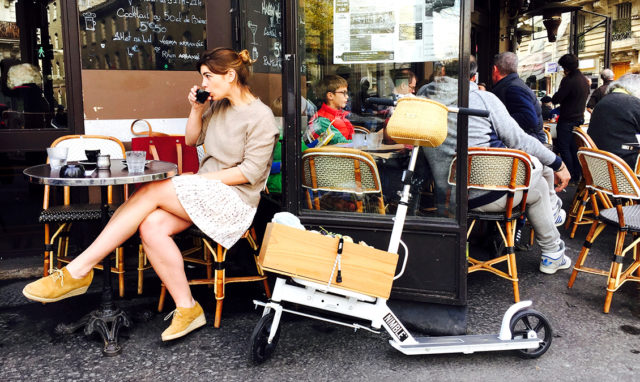
Cargo Scooters: Innovating Transportation for Micro-distances
mai 17, 2016 — Uncategorized
Q&A with Alix Armour, Co Founder/CEO, Nimble Scooters
NewCities: You have just successfully funded the world’s first cargo scooter, The Nimble Urban, through a crowdfunding campaign. How has Nimble Scooters evolved as a mobility solution and as a young startup since you joined NewCities at our Making the Future City event two years ago?
Alix Armour: In the fall of 2014, we were still discovering the market, getting feedback and interest from all sorts of individuals, retailers and users. The bulk of the work that year was about figuring out who were our most important clients and where to focus on. In 2015 we decided to bring two new models to the market. In response to the feedback, we needed two unique designs, an urban solution as well as an industrial model. In less than a year, we sketched, prototyped, manufactured and found clients for our new models. This past month, we delivered our first production of Nimble XL, the industrial 5-wheel scooter, to clients and retailers in the USA and Europe. In parallel, we launched a successful crowdfunding campaign for the Nimble Urban, validating our research and expectations for the urban market. Today, our objective is not ¨making scooters¨, it´s about developing innovative mobility solutions.

NCF: How does Nimble Scooters combine people and goods transportation? On a larger scale, are there new opportunities for collaboration between people and freight transportation in cities?
AA: The human factor is still very important when it comes to the delivery chain. Of course, today you can choose from numerous services that do not involve people, such as package delivery by mail, vending machine or packaged gift boxes. But at the end of the day, a company is still looking for ways to interact with their customers. A person delivering goods is one of the last brand experiences after purchasing a product.
What we found out about the Nimble Urban is that it encourages and enhances human contact in a city. Whether you´re delivering goods for a company or going to the market, it´s easier to interact with people than if on a bicycle or in a car. Unlike a bicycle, a kick scooter can be ridden on sidewalks, it´s compact enough to be taken into stores, you can stop easily any time to greet familiar faces – you are part of the walking crowd. At the same time you can go faster and get things done more efficiently. Being on the sidewalk is what makes the Nimble Urban people-friendly.
In the future, I envision companies choosing all types of different mobility solutions for their freight transportation based on their values, branding and needs, whether it´s bikes, scooters, electric micro cars or shared solutions.
NCF: People are becoming increasingly flexible and multi-modal in their mobility solutions, especially in cities. How can Nimble Scooters be combined with other transport solutions available today?
AA: Some people store their Nimble Urban on a boat, so that when they arrive at a port, they can easily take a kick-scooter and go grocery shopping with it. Some take the larger Nimble XL in their truck, to use on site for a construction project.
I´ve taken the Nimble Urban on a train to go from Paris to Berlin. My suitcase was attached on the Urban, with which I scooted to the train station. Once on the train, I folded it up and store it for the journey, then re-attached the bag once we had arrived. From the Berlin Hauptbahnhof, I scooted past the Brandenburg Gate and Reichstag, to my destination 3 km away. Because of the slower pace of the scooter, I felt like I was able to absorb more of my environment than if on a bicycle or bus. I was even stopped a few times by people commenting on my unique mode of transportation – giving me the opportunity to interact with locals and a chance to make friends.
NCF: Nimble Scooters is a low-tech solution, yet the majority of innovation in the mobility sector stems from technology, data and smart infrastructure. How can entrepreneurs still use low-tech ideas to grow successful startups?
AA: There is quite a lot of initial risk and investment required for high tech solutions and smart structures.These markets often require more investment in tech research and development such as electrical engineering, AI, etc. By starting with a simple product and becoming an expert in our markets with low tech solutions first, we can more easily identify new markets that are worth getting into.
Also, making a physical product is very different than making an app-based service or system. There is inventory involved, logistics, import taxes and customs…a whole other level of development that needs to be identified before being able to grow. The process is slower perhaps, but allows us to digest what is happening with current trends.